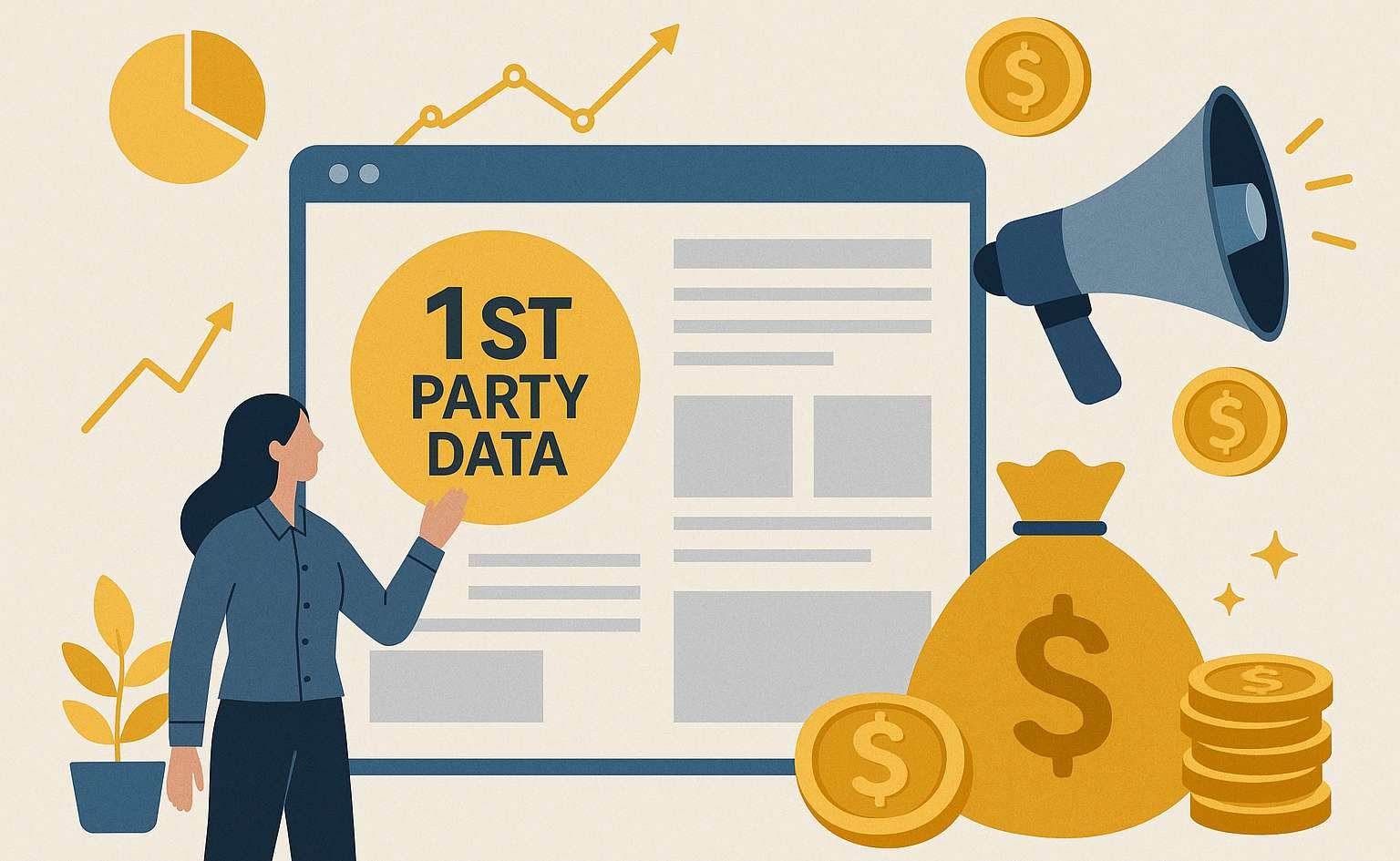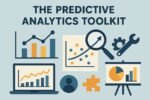Introduction to First-Party Data
Also referred to as zero- or owned-party data, first-party data is information collected directly from a company’s own audience or customers, making it among the most valuable data in digital advertising. Unlike third-party data, which is purchased, brokered, or scraped, first-party data is gathered through direct interaction with users. Within these interactions, a wide range of data points can be collected, such as identifiers like names, email and home addresses, phone numbers, and company websites, or preference and interest details, including favorite artists or preferred car models. Marketers leverage these data points to craft targeted advertisements tailored to specific individuals and their interests.
First-party data offers marketers and advertisers several competitive advantages. It is the only data set truly collected with users’ consent and subsequently safeguarded according to data protection regulations; in contrast, third-party data is frequently collected surreptitiously. As digital browsers implement restrictions against third-party cookies and other tracking methods, first-party data emerges as an overriding force capable of cultivating new business models, maintaining existing ones, and creating lucrative opportunities for companies positioned to collect and manage the data effectively. Ultimately, first-party data is driving a new gold rush in digital advertising.
The Importance of First-Party Data
First-party data has become a marketer’s most prized asset. It comes from customer touchpoints, events, behavior, demographic data, preferences, and personally identifiable information (PII) collected between a company and its customers or users—typically through transactions, products, websites, or CRM systems. Brands use it to develop messages and experiences that resonate with their audience, establishing clear signals of intent and interest for featured products, while highlighting the uniqueness of the user’s journey.
The value of first-party data—tracked across a consumer’s visit to a brand or retailer—has made it imperative for marketers aiming to refine marketing spend, prioritize their target audiences, and craft relevant content and customer journeys across channels. In essence, the focus of digital advertising has shifted; rather than connecting marketers with advertisers and vice versa, advertisers are now seeking audiences closer to their products. The available supply of such audiences from 1P data sources is the new gold rush.
Types of First-Party Data
First-party data comprises information that marketers collect directly from their own sources, such as websites, mobile applications, offline channels, or other customer touchpoints. Three main categories of first-party data exist: transactional, behavioral, and demographic. Transactional data, including sales transactions, customer service interactions, and payment history, offers insight into customers’ purchases and interactions with the brand. Behavioral data, defined by website and mobile app usage activity, illustrates how customers interact with different products or content. Demographic data provides information about customers’ gender, age, geography, and other classification groups. Many marketers also consider explicit and implicit customer engagement data, such as survey results, call center data, and email interactions, to constitute unique first-party datasets.
First-party data enables more effective targeted advertising as it reflects the actual behavioral patterns of existing customers or subscribers and provides an unbiased view of targeting strategies. Generally, first-party data makes advertising more effective at each stage of the consumer journey. When first-party data distinguishes successive phases of the funnel, it informs lookalike modeling and helps identify different audiences for driving awareness, preferences, or purchase—and ultimately, customer value.
Transactional Data
Transactional data is the record of a customer’s interaction with a brand, covering the customer’s purchase journey, spread across multiple touchpoints, and collected by the brand itself. Examples include transactional data collected through loyalty program platforms, point-of-sale devices, and credit card transactions.
The description is similar to behavioral data, yet the two types differ. Behavioral data covers all actions, ranging from website navigation to interacting with loyalty program touchpoints and points redemption. Transactional data focuses solely on the purchase itself. Transactional data is useful for remarketing or acquiring new customers, as it provides a track record of a customer’s purchases. In personalization, advertisers can offer similar products to prospective buyers and cross-sell products to existing customers.
Behavioral Data
First-party behavioral data captures actions a user takes with a brand and is used to predict future actions, such as making a purchase. There is a closer correlation between behavior and intent than with any other type of data, making behavioral data deeply valuable for advertisers. Behavioral data seeks to capture what happens after a customer or user sees an ad or encounters a brand in the market—to inform optimized ad targeting toward making a sale. This data tracks activities such as past purchases or visits to a website.
Other types of behavior can be captured, including how users behave on the web, the types of media they consume in their free time, brand responses to customer requests, and points of customer service support. Behavioral data relates to digital platforms in different ways, with some advertising players capable of collecting or activating behavioral data. Some platforms offer measurement insights or predictive models driven by user actions that allow for propagation and insights into behavioral trends. Behavioral data serves two primary uses in digital advertising: targeting and personalization. Targeting positions media in front of audiences most likely to take a brand-desired action, while personalization creates digital experiences centered around a user’s likely intent.
Demographic Data
Another type of first-party information used particularly in paid advertisements includes demographics, such as age rage, gender, and employment type. Collection often uses browser cookies, which are files stored locally within the user’s browser. These files help track pages visited, online viewing duration, newsletter subscriptions, and purchases made. Furthermore, analyzing interactions with these capture pages, like links clicked or images viewed, offers insight into interests and purchasing behaviors. With this information, businesses tailor product recommendations and provide services according to the identified profiles.
Engagement Data
First-party data is information a company collects directly from its prospects and customers—through webforms, online surveys, past purchase behavior, live chat transcripts, social media, and so on. As marketers become increasingly aware of the value of first-party data, businesses of all sizes are racing to collect, protect, and organize that data for use in hyper-targeted digital advertising.
First-party transactional data reveals who purchased what and when. Behavioral data tracks interactions with the company’s website and digital ads. The data is designed to optimize ad targeting and improve bidding decisions. Demographic first-party data includes information about individuals’ identifying characteristics (age, gender, income range, job title, interests, and so on). Engagement data includes the data gathered about customers: if a customer unsubscribes from a company newsletter, for example, the company will know that person doesn’t want to receive communications in their inbox.
Collecting First-Party Data
First-party data is information collected directly from customers and prospects by organizations and brands. Collecting this data both online and offline provides a business with a competitive advantage while reducing dependence on third-party cookies. It is also the most trustworthy source of data because customers willingly share it with the store, app, or website relationship they have engaged with. Additionally, organizations can collect first-party data from business partners or other trusted relationships. This approach builds robustness into marketing strategies, as any gaps in first-party data can be supplemented by second- or third-party data.
Collecting first-party data is straightforward. Offline first-party data is obtained from in-person customer interactions, in-store transactions, customer service calls with associates, or through programs such as rebates and product registrations. Online first-party data is gathered when users engage with a mobile app or website, such as opening an app for real-time push notifications, subscribing to an email newsletter, or browsing products on a website.
Methods of Collection
First-party data derives directly from a company’s own audience and customers. In contrast, third-party data is acquired elsewhere, often amassed through cookie tracking on websites visited by your target audience. Indeed, third-party cookies facilitate the collection of audience data from users who have visited sites other than your own and permit retargeting and targeting ads to those audiences. However, securing direct, explicit customer data invariably represents a more valuable and strategic resource. It’s also the data set least susceptible to disruption—an especially crucial consideration in rapidly evolving marketing ecosystems.
Security, data quality, and compliance are paramount. The bedrock of any successful first-party data initiative is a secure, consent-driven, consent-rich collection setup and storage process. Although many organizations already have systems capable of capturing customer data, current regulatory requirements specify that the data owners—in this case, the customers—must give their explicit permission for its use in marketing campaigns. Consent obtained via registration websites, mobile apps, loyalty programs, surveys, and other mechanisms plays a critical role in building and maintaining high-quality first-party data. Recognizing the heightened stakes associated with first-party data, some marketing leaders now consider first-party data management the new corner office for marketers.
Best Practices
First-party data has become the holy grail of digital advertising. The decreasing availability of third-party cookies makes it the most powerful way to connect with customers and prospects. Predictably, everyone is rushing to clamor for first-party data. But the best relationships rely on trust—and marketing is no exception.
A strategy that prioritizes responsible data collection and use can build trust while providing the insights needed for advertising success. With smart tools, marketers don’t have to sacrifice personalization or business growth.
First-Party Data vs. Third-Party Data
The roles of first-party data versus third-party data, and the differences between them, are largely defined by the advertiser’s relationship with the consumer. Advertisers collect first-party data directly from the consumer, whereas the latter is aggregated and compiled by other companies—third parties—that are unaffiliated with the original transactions or customer relationship. First-party data is generally viewed as more reliable because it is obtained through direct interaction. Third-party data may contain outdated or irrelevant information and may have been collected, stored, and shared without the consumer’s knowledge or explicit consent. Given that first-party data is not shared with, or sold to, other businesses, the risk of data breaches and misuse is minimized.
While businesses collect and utilize multiple types of data, many seek to prioritize first-party information—details obtained directly from their customers. These high-value data sets are often used in targeted advertising, ad personalization, and advertising effectiveness measurement.
Key Differences
First-party data, or known customer data, refers to the information a business collects directly from its customers, clients, and audiences. Characteristics include consideration of the data subject, commercial use, and collection method. First-party data embodies the principle of “putting the subject first,” while holding the business accountable when handling personal information. Privacy laws require businesses to obtain valid consent before collecting personal data for commercial use. Data sources for collection include a company’s own websites, apps, social media, or brick-and-mortar stores. These attributes make first-party data highly valuable for companies.
By contrast, third-party data—information a company may purchase or license—comes from sources not directly connected to the business, such as aggregators, data brokers, and external organizations. Because a company obtains data from a party not directly related to the individual in question, the individual is further removed from the process. Regulations often require that the original party obtain consent before collecting or sharing data with consumers, businesses, or other organizations. A business’s use of third-party data is dependent on another entity’s collection effort, quality assurance, and storage practices.
Advantages of First-Party Data
Advocates of first-party data use point to the ability it affords advertisers to reach their core audience by leveraging data that is directly related to the customer or prospect. For example, advertisers that collect first-party data from transactions or content consumption from a website have information on demographics, shopping behaviors, and other compiled custom segment definitions that they can use for targeting specific messages and offers. By contrast, third-party vendors typically have access to broad market definitions, rather than detailed information on customer behavior.
The rise of data privacy concerns and legal oversight continues to spur more organizations to develop their position on first-party data. Some observers regard an increased focus on first-party data as a new “gold rush” in digital ads. It is evident from such a perspective that those who control direct user information have disrupted the programmatic auction by bypassing the need for intermediaries, allowing them to behave more like a private marketplace that is far less transparent.
Privacy Considerations
The rise in concerns over privacy and more stringent data protection regulations, such as the General Data Protection Regulation (GDPR) in Europe and the California Consumer Privacy Act (CCPA) in the United States, has made advertisers and marketers realize the importance of obtaining explicit user consent before capturing personal data. Consumers are increasingly turning to privacy-focused services that offer ad blocking, anti-tracking, and other anti-data collection measures. Given the growing regulatory scrutiny and consumer awareness, the use of third-party solutions has become more difficult. Advertisers are thus investing more in first-party tools and solutions that enable them to personalize services and oversee the entire data supply chain, ensuring transparency and control over the collection and usage of customer data.
First-party data is the new gold for marketers amidst the phasing out of cookie tracking. However, privacy legislation such as the Personal Data Protection Act (PDPA) mandates that personal data must be collected for legitimate purposes, stored in a secure manner, and used only for the reasons where necessary consent has been obtained; reliance on last-minute fraud and anti-spam rules will be inadequate if the organization does not adopt such a comprehensive approach. The possibility of re-identification using anonymized data can become a sneaky threat when organizations start relying on AI and machine learning, as the combination of big data and new technology is already challenging the de-identification of data.
Data Protection Regulations
Data protection regulations govern the collection and use of first-party data. Such laws require marketers who obtain user data for promotional reasons to clearly inform individuals about their data collection purposes. California’s CCPA is the most notable example of recent changes. It has garnered significant attention due to the size of the state’s economy and its associated population.
The European Union’s General Data Protection Regulation (GDPR) was implemented in 2016. This groundbreaking legislation compelled many world leaders to reconsider their privacy regulation policies, resulting in a ripple effect. In addition to establishing continental standards, the regulation also set a precedent around the globe.
User Consent
Privacy regulations worldwide govern how consumer data can be leveraged for targeted marketing. GDPR was the pioneer in instating principles of consumer privacy, and legislation has continued to evolve, reflecting shifting government attitudes towards consumer privacy. Consumer attention to privacy is at an all-time high, with data breaches increasing and media stories highlighting privacy scandals.
First-party data, although often deemed to be less susceptible to privacy concerns, alights on the same challenges posed by regulations including GDPR and CCPA. Opt-in is a key best practice for first-party data. Users should always trigger the interaction that results in data capture and be given the choice to opt out of that data being used for retargeting or profiling. Allowing users an avenue to opt out of these capabilities reduces the risk associated with first-party data collection and addresses consumer concerns at the same time.
Utilizing First-Party Data in Advertising
Marketing and ad-tech companies use first-party data mainly for targeted advertising. By employing marketing automation and data management platforms (DMPs), first-party customer insights can be integrated with the corresponding users visiting websites or apps to identify and segment interest groups for precise advertising. Standard advertising metrics—such as conversion rates, cost per click, cost per acquisition, and ad spend—are directly influenced by the application of first-party data, with advertisers and agencies leveraging such information to optimize bidding strategies on digital media buying platforms. The use of online browsing behavior and activity data also enables behavioral targeting, assisting advertisers in reaching users who have searched for specific products on e-commerce sites. However, reliance on data sourced directly from retail websites may lead to high conversion rates but at increased costs per click.
Even if external-retail-data and transaction-data-based behavioral targeting strategies lack the elegance of targeting audiences precisely within a retailer’s own ecosystem, they have proven effective in driving traffic and conversions during crucial online seasonal events such as New Year, Labor Day, Singles’ Day, Christmas, and New Year’s Eve. In fact, for some businesses, these first-party queries and transaction data may rank as the most valuable sources of traffic and conversions.
Targeted Advertising
When companies possess information about an audience of an existing customer base, such as a registered users of a music-streaming service, they can serve advertisements for paid tiers of the service only to users who have not yet subscribed. In addition to conversion potential, target audience and lookalike advertising with first-party data enables the ability to have granular profiles for targeting to be accurate and relevant.
Utilizing first-party data allows marketers to customize advertisements by including the last product or category the potential customer viewed, or even the status of an order. Other highly relevant messages include promoting complementary products, related products, items which have been newly released, product usage messages, price drop notifications, light-user appeals, and cross-selling for other business categories, functions, regional and more.
Personalization Strategies
Personalization has become an essential part of marketing for any brand — including digital advertising. A lot of first-party data gets captured during those experiences, creating opportunities for brands to use their information and target these users in future advertising efforts with relevant messaging or promotions. Maintaining consistent targeting throughout a customer journey is a long held best practice and can have a dramatic effect on the effectiveness of the campaigns.
Sticking with the example of an e-commerce retailer, a browser abandons their shopping cart just before checkout. Using first-party data captured from that event, a marketer can target a display ad to that user promoting free shipping or discounts in order to push them back to complete their purchase.
Challenges in First-Party Data Usage
With the rapidly increasing importance marketers have placed on leveraging first-party data for digital advertising, challenges and limitations have become apparent—especially when compared with third-party data. While theorizing about the benefits of first-party data is easy, practical implementation comes with many caveats.
Quality challenges are a major issue. Onboarding first-party data and activating it for addressable campaigns in a privacy-compliant manner is problematic. However, emerging platforms enable marketers to load all customer data, conduct modeling to account for unobserved customers in the first-party ecosystem, and activate the data for paid media campaigns. Leveraging other identity-compliant data sets can amplify the value of first-party data. Attrition and data refresh are also critical concerns—customer single-opt-in databases degrade over time as customers unsubscribe or do not update their information. Therefore, marketers must continuously revalidate and refresh their lists. Moreover, even with first-party data, understanding which conversion and event types perform best and which audience segments are most valuable is essential. Conducting data audits to analyze historical first-party data and experiment with various subsets helps determine the optimal data for advertising purposes.
Data Quality Issues
Business-to-Business (B2B) marketers spend more than half of their budgets on acquiring new business, yet new business records and leads often lack the quality that ensures high conversion rates. Poor-quality data with low completeness and accuracy negatively affects the outcome and return on investment of many marketing, sales, and service processes.
High-quality customer data, enriched with external sources of official company business information and demographics, can instantly provide a more complete and accurate picture of customers and prospects. Business-to-Consumer (B2C) Consumers want increased personalization and customized experiences, yet refuse to provide the details and information needed to enable it. Directly asking for personal information, however, can lead to exceedingly low data-quality scores in latency, coverage, and protection. By enriching with first-party internal data, marketers and publishers can use a one-to-one relationship with both anonymous and opted-in users.
Integration with Other Data Sources
Marketers don’t rely on first-party data alone. They mix in other data types to get a better view of users. The challenge, of course, is collecting and managing that outside information. They try to use outside data without losing the trust of users or running afoul of data privacy laws. Still, the integration effort offers advantages.
First-party data is precise, highly relevant and based on user consent. Marketers can integrate it with third-party data to target new audiences, such as adding data about people who buy children’s diapers to find folks likely to have young kids in their households. Using other data with first-party data enables targeting around broader interests.
Case Studies
Successful first-party data implementations offer valuable lessons for organizations considering similar strategies. Confectionery company Mars employed first-party data to optimize consumer engagement and brand awareness during the pandemic. By uniting data assets and establishing governance frameworks, Mars ensured data quality and control, paving the way for a first-party data-driven future. The dark days of the pandemic also revealed the power of transparent communication. The pension fund provider PGB used first-party cookies and data-matching to gain deeper customer insights. Recognizing that privacy is paramount, PGB was explicit about the benefits of using the data. They established trust, enabling the company to deliver timely, relevant messages and add value to customer interactions.
Masonry materials supplier Saint-Gobain Building Distribution gathered first-party data from website traffic, despite a low proportion of transactions completing online. By capturing key business profiles, the company targeted web visitors accurately and tailored follow-up communications, transforming Saint-Gobain’s use of first-party data, aided by cross-channel integration, into a marketing and sales game changer. Specialist insurer Vero used digital-first techniques to build a first-party data asset at scale. As a smaller player, Vero needed to get its brand out quickly, both with brokers and within its core professional niches. Using first-party data, Vero drove highly targeted media campaigns, showing that data is no longer just the preserve of the large and well-established.
Successful Implementations
First-party data has ushered in a new gold rush in digital advertising, as marketers draw on these internal client data sources to enhance ad targeting and personalization. The shift toward first-party data is driven largely by the imposition of user privacy regulations, the impending death of third-party cookies, and growing consumer awareness of data privacy. Surveys reveal that more than 90% of marketers consider first-party data important or very important for the future of digital advertising.
In the retail sector, Boohoo has employed first-party data for predictive modeling to enhance personalized marketing. Implementation began by leveraging data from customers’ past shopping experiences, such as transaction details, demographics, and psychographics. These insights were then applied to new customers who visited Etsy to generate targeted offer coupons designed to encourage immediate purchase decisions. Experiments utilizing buy-one-get-one-free offers, free delivery, and percentage discounts indicated that free delivery was particularly effective among new customers. The strategy reached nearly one million new customers in just 80 days.
Lessons Learned
The emergence of consumers’ privacy concerns and sweeping privacy regulations such as the GDPR, the California Consumer Privacy Act, and the Virginia Consumer Data Protection Act have all contributed to keeping marketers on their toes in their efforts to leverage first-party data in advertising. Following Google’s announcement that it would phase out third-party cookies on the Chrome browser, marketers have rushed to build up and enhance their first-party data sources for marketing. Yet many marketers are facing difficulty in leveraging first-party data due to data quality issues such as incomplete, messy, and unstructured data.
The landscape of third-party data, which marketers have used extensively over the past decade, has also changed dramatically. Measures such as new privacy control deployments by leading platforms, regulatory enforcement such as Google’s fine for illegal cookie use in France, and cases like Hopper’s controversy for the resale of third-party data constantly remind marketers that third-party data carries a greater risk than ever before. As a result, many marketers who have relied heavily on third-party data for targeting advertising on digital channels are reconsidering their options and increasingly turning to first-party data for marketing.
Future Trends in First-Party Data
As the use of cookies and third-party data in digital advertising continues to decline, brands and retailers face new challenges in understanding and reaching consumers. This shift has triggered a “gold rush” for first-party data among these entities. A recent study by NielsenIQ found that after price, consumers rank data privacy as their second highest concern. Moreover, 69% of marketers believe that privacy-first advertising will be a differentiator for their brand by 2025.
These rapidly evolving circumstances have led to significant transformations in first-party data strategies. Marketers are proactively integrating first-party data with other proprietary or confidential sources and exploring partnerships with trusted entities to enhance their advertising approaches. For instance, the Council of Better Business Bureaus recently launched AdDataTrust, a new program designed to enable brand advertisers as well as retailers and manufacturers with high-quality first-party data to collaborate in a privacy-compliant manner.
Emerging Technologies
Providers supporting first-party data allow marketers to more fully exploit the wealth of information they already own. Delving into use cases such as site-retargeting, a core part of many targeting strategies built upon behavioral data, demonstrates how learning from visitors‟ behaviors can inform ever more targeted prompts. However, many of a website‟s visitors never return to buy, and for online retailers, these untapped prospects can be especially fertile ground for marketing in other channels. Enriching site-retargeting lists with additional criteria, how they browsed, when was their last visit, and what other demographic or purchase data might suggest about their likelihood to return to buy, can be powerfully effective for advertisers seeking to be about to reach them with targeted ads elsewhere.
A key area of disruption for emerging technologies is the deployment of Artificial Intelligence (AI). Plugging client first-party data into AI engines enables them to make better predictions on which products a customer should be targeted with, thus driving better paid search campaigns or delivering better content, product recommendations, and personalized experiences. Given the richness of the data, it comes as no surprise that business intelligence and insight platforms also benefit by leveraging first-party data when performing clustering analysis, propensity modelling, calculating customer lifetime value, and other empathic categorisations. Moreover, increasing numbers of retailers, both online and offline, recognize that first-party data can exponentially amplify marketing strategies and allow them to surpass more traditional peers. Forward-thinking technology providers appreciate that equipping clients with first-party data overlays can unlock new growth opportunities with verticals previously considered low-value. With these possibilities in mind, marketers should discern which partners can truly exploit the treasure trove of data they already own.
Predictions for the Industry
A first-party-data-driven strategy often requires overcoming challenges in data management, unifying a data ecosystem, and dealing with a limited inventory of cookies and mobile IDs. Companies should keep in mind that not all first-party data are created equal: Email addresses are highly valued due to their longevity and member recognition, whereas device IDs are less so because they frequently change and correlate with smartphones instead of individuals. Given these differing values, an ID graph becomes crucial in combining the dataset and maximizing its effectiveness.
First-party data is destined to become a key competitive advantage in digital marketing. By collecting, unifying, and activating such data effectively, companies can deepen consumer insights and, in turn, deliver impactful personalized marketing at scale.
Conclusion
First-party data is information collected from users directly by a business, providing the opportunity to add meaningful context to advertising campaigns. As businesses seek data that allows them to bypass third-party cookie restrictions, which impact targeting and attribution capabilities, the race to collect consumer data has intensified. Formerly a tourism guide, Joe Jaffee now cares for a sprawling first-party-data eco-system, a shift emblematic of the broader industry. Marketers prize first-party data because it is stored and owned by their own company, meaning that it can be leveraged without the risk of losing it or facing rising prices. The main types of first-party data include transactional (product purchase history), behavioral (individual activity on a company’s website), demographic (social-economic factors), and engagement (interactions with a company’s marketing channels). Numerous guidelines exist to help companies collect first-party data responsibly and efficiently, balancing marketing strategies with user privacy.












